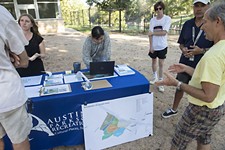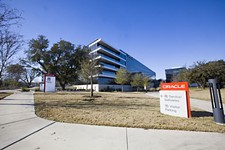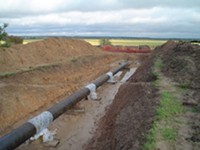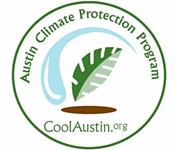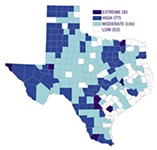Chain-Saw Frenzy
Fear of a Springs PARD massacre is about trust as well as trees
By Katherine Gregor, Fri., May 8, 2009
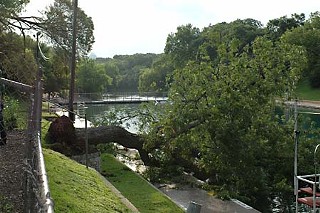
The city's Parks & Recreation Department climbed out on a dangerous public relations limb April 15, when it announced as a seeming fait accompli a city plan to chop down 28 to 30 big, beloved trees surrounding Barton Springs Pool. The assessment of the trees' health had been conducted as part of the Barton Springs Pool Master Plan project. Since then, the fate of 46 aging and ailing trees – a few majestic, others near-dead – has attracted predictable citizen outcry. Some responses have trended conspiratorial (it's all a plot to clear land for a new bathhouse); others have been knowledgeable and reasoned (specific trees could be treated and monitored, rather than immediately removed).
New PARD Director Sara Hensley tempered the plan by allowing 60 to 90 days for public meetings and input, as well as consideration by a joint subcommittee of the Environmental and Parks boards and the Urban Forestry Board. Possibly by June, PARD will make a final determination as to which of the diseased, damaged, or "overmature" trees (mostly pecans, cottonwoods, and American elm) are so likely to topple that, in the interest of public safety, they must be removed and replaced with younger trees.
Notable in the public response has been a spirit of distrust and suspicion toward PARD. Some citizens behaved rudely at a public joint board meeting April 20; when disrespectful behavior erupted again at the Parks board last week – running from protest signs through catcalls, shouting, and booing of Urban Forestry Program Manager Walter Passmore – Chair Linda Guerrero had to call a recess and scold the citizens to restore order. Later, she acknowledged that PARD has helped create the mistrust, which she said "stems from a long trail of broken promises to the community."
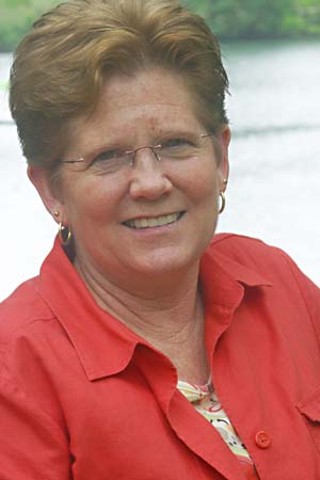
Hensley, with about four months on the job, has embraced the controversy as a chance to redeem that history. "We have some work to do – obviously – here in this department, to rebuild the trust lost with our community," she told the Chronicle recently. "I think this is a great opportunity to help rebuild the trust. I truly believe in public involvement and engagement. People need to see that I'm the kind of person that, when I say I'm going to do something – or that I'm not going to do something – I keep my word." Even those who don't agree with every recommendation, she believes, will respect the process as honest, open, and fair.
Some tree advocates scoff at the safety risks, suggesting park patrons should simply be required to sign a liability waiver. But the danger is real, especially during bad weather. Last August, when a large branch fell suddenly over a parking lot, a Zilker Park visitor was hospitalized and five cars damaged.
A careful reading of the $250,000 Tree Assessment Report prepared by Davey Resource Group (see www.cityofaustin.org/news/2009/barton_springs_2009.htm) shows that of the 46 questionable trees assessed, only a few were recommended strongly for removal. For the others rated at highest risk of failure, the report typically states: "It is recommended that the tree be considered for removal. If the tree is not removed, it is recommended that the tree be reviewed by a City arborist semiannually for any changes in condition or stability [emphasis added]." Passmore ultimately translated the consultants' findings into an announced plan for fast removal of 28 trees – including other far-gone specimens he added to the list. Critics say that conclusion was overly weighted toward tree removal.
An underlying issue is that perennially underfunded PARD has for decades conducted insufficient arboral care and tree-planting. Online newsletter In Fact Daily quoted Passmore saying at the Parks board: "Nationwide there's a goal to treat trees on a seven-year cycle. Our staff and budget allows a treatment cycle of 40 years. So you can see there's a fairly large disparity between the maintenance we're able to do and maintenance that is a recommended goal." PARD spokesman Victor Ovalle said the 22 staffers in PARD's Urban Forestry division must spread their resources over 300,000 trees; just 6,000 have received care this year.
A number of local arborists have said that some trees could be preserved safely with proper care and monitoring. A professional second-opinion assessment was published April 30 by arborist Don Gardner (see www.sosalliance.org) at the request of Save Our Springs Alliance. Gardner mostly lauded the Davey Group report but disagreed with the PARD staff conclusions. He also noted, "Tree risk assessments have subjective components, and good arborists can have strong disagreements about the same tree."
"At least four trees on the removal list are not safe and need to be removed," Gardner concluded. "Four or five others need additional testing to determine if they are healthy enough to retain. The rest do not need to be removed." He recommended proactive health-care measures. Two of the unsafe trees are in the playground area and pose a particular risk to children (a portion of the playground has been closed for that reason). To safely preserve others, public access would have to be prohibited in 60-foot swaths around the trees and prevented entirely during storms.
Hensley said she's committed to redirecting negative community energy into positive commitments to help PARD step up its tree-care and tree-planting programs – and to building trust along the way. "I think she's doing a really great job of trying to get her staff to respond in a very transparent and open manner," said Guerrero. Echoed Charlie McCabe, executive director of the Austin Parks Foundation: "The director is leading by example, disclosing all of the data gathered thus far, listening to input, getting other experts to weigh in, and hopefully coming up with a good plan that balances the needs, desires, and risks."
Public Presentations
Barton Springs Tree Tour, May 15, 3 & 6pm, meet at Barton Springs Pool entrance
Urban Forestry Board, May 19, 6:30pm, Mexican American Cultural Center, 600 River St.
Environmental Board, May 20, 6pm, Austin City Hall, 301 W. Second
Got something to say on the subject? Send a letter to the editor.





